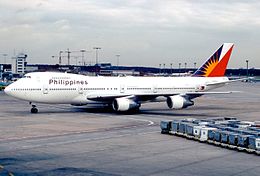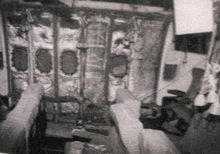Philippine Airlines (PAL) is the flag carrier of the Philippines. Headquartered at the PNB Financial Center in Pasay, the airline was founded in 1941 and is the oldest operating commercial airline in Asia.
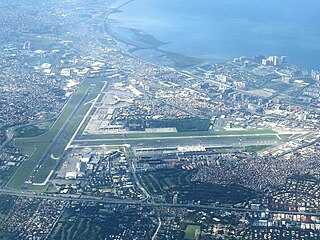
Ninoy Aquino International Airport, originally known as Manila International Airport (MIA), is the main international airport serving Metro Manila in the Philippines. Located between the cities of Pasay and Parañaque, about 7 kilometers (4.3 mi) south of Manila proper and southwest of Makati, it is the main gateway for travelers to the Philippines and serves as a hub for PAL Express, and Philippine Airlines. It is also the main operating base for AirSWIFT, Cebgo, Cebu Pacific, and Philippines AirAsia.

On December 22, 2001, a failed shoe bombing attempt occurred aboard American Airlines Flight 63. The aircraft, a Boeing 767-300ER with 197 passengers and crew aboard, was flying from Charles de Gaulle Airport in Paris, France, to Miami International Airport in the U.S. state of Florida.
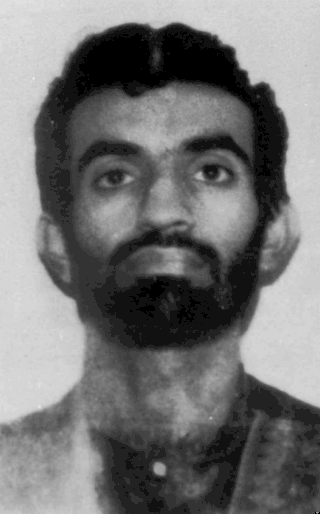
Ramzi Ahmed Yousef is a convicted terrorist who was one of the main perpetrators of the 1993 World Trade Center bombing and the bombing of Philippine Airlines Flight 434; he was also a co-conspirator in the Bojinka plot. In 1995, he was arrested by the Pakistani Inter-Services Intelligence (ISI) and U.S. Diplomatic Security Service at a guest house in Islamabad, Pakistan, while trying to set a bomb in a doll, then extradited to the United States.

The Bojinka plot was a large-scale, three-phase terrorist attack planned by Ramzi Yousef and Khalid Sheikh Mohammed for January 1995. They planned to assassinate Pope John Paul II; blow up 11 airliners in flight from Asia to the United States, with the goal of killing approximately 4,000 passengers and shutting down air travel around the world; and crash a plane into the headquarters of the United States Central Intelligence Agency (CIA) in Fairfax County, Virginia.
Abdul Hakim Ali Hashim Murad is a Pakistani Islamist terrorist, who was a co-conspirator in the Bojinka plot—the forerunner to the September 11 attacks. In 1996, he was convicted in the United States of trying to blow up a dozen airliners and was sentenced to life in prison.
Cebu Air, Inc., operating as Cebu Pacific, is a Philippine low-cost airline based at Pasay in Metro Manila. Founded in 1988, it is Asia's first low-cost airline. It offers scheduled flights to both domestic and international destinations. The airline operates flights from five bases in Cebu, Clark, Davao, Iloilo, and its largest base in Manila.

Francisco Bangoy International Airport, also commonly known as Davao International Airport, is the main airport serving Davao City and Davao Region in the Philippines. Serving as the main gateway to Mindanao, it is the busiest airport on the island and the third busiest in the Philippines in 2022.

Cebgo, Inc., operating as Cebgo, is the regional brand of Cebu Pacific. It is the successor company to SEAIR, Inc., which previously operated as South East Asian Airlines and Tigerair Philippines. It is now owned by JG Summit, the parent company of Cebu Pacific which operates the airline. The airline's main base has been transferred from Clark International Airport in Angeles City to Ninoy Aquino International Airport in Metro Manila. On April 30, 2017, Cebgo planned to move out from Manila and transfer its main base to Mactan–Cebu International Airport in Cebu City because NAIA has already maxed out its capacity. Currently, it operates an all-ATR fleet, with a total of 16 in service.

Zamboanga International Airport is the main airport serving Zamboanga City in the Philippines. Located on a 270-hectare (670-acre) site in Barangay Canelar, Zamboanga City, the airport is Mindanao's third-busiest airport after Francisco Bangoy International Airport in Davao City and Laguindingan Airport in Laguindingan, Misamis Oriental.

Godofredo P. Ramos Airport, also known as Caticlan Airport and recently, Boracay Airport by its developer Trans Aire, is an airport serving the general area of the municipality of Malay, located in the province of Aklan in the Philippines. It is one of the two gateways to Boracay, the other being Kalibo International Airport in Kalibo. The airport is classified as a Class 1 principal airport by the Civil Aviation Authority of the Philippines.
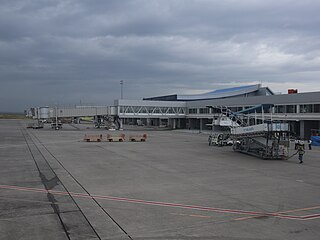
General Santos International Airport, also known as Tambler Airport, is an alternate international airport located in the city of General Santos, Philippines serving the greater area of Soccsksargen. Situated in Fatima, General Santos, it is a large airport on the island of Mindanao and is officially classified as an international airport by the Civil Aviation Authority of the Philippines (CAAP), a government bureau which is responsible for the management and operations of General Santos International Airport and all other airports in the country except regular international airports.

Daniel Z. Romualdez Airport, also known as Tacloban City Airport, is an airport serving the general area of Tacloban, a highly urbanized city in the Leyte island of the Philippines. It is the main gateway from Manila and Cebu to Eastern Visayas. It is classified as a Class 1 principal airport by the Civil Aviation Authority of the Philippines. In 2022, Daniel Z. Romualdez Airport served 1.48 million passengers, making it the seventh-busiest in the country.

Pan Am Flight 830 was a flight from New Tokyo International Airport in Tokyo, Japan, to Honolulu International Airport in Hawaii. On August 11, 1982, the Boeing 747-121 serving the flight, nicknamed Clipper Ocean Rover, was en route to Hawaii when the airplane was damaged by a bomb that had been placed on board. Despite the damage to the aircraft, Captain James E. "Skipper" O'Halloran III, of Spokane, Washington, was able to land in Honolulu safely. One person was killed while 284 survived; 16 of them were wounded.

Labo Airport, also known as Ozamiz Airport, is an airport serving the general area of the city of Ozamiz in the Philippines. It is the only airport in the province of Misamis Occidental. The airport is classified as a community airport by the Civil Aviation Authority of the Philippines, a body of the Department of Transportation that is responsible for the operations of not only this airport but also of all other airports in the Philippines except the major international airports. It is one of only two community airports in the Philippines with commercial operations, but one of the busiest in Mindanao in terms of aircraft movement and passenger traffic.

Philippine Airlines Flight 206 (PR206) was the route designator of a domestic flight from Manila Domestic Airport, Metro Manila, Philippines, to Loakan Airport, Baguio. On June 26, 1987, the Hawker Siddeley HS 748 crashed onto a mountain en route to Baguio, killing all 50 people on board.
Air Philippines Corporation, operating as PAL Express and formerly branded as Air Philippines and Airphil Express, is a wholly-owned subsidiary airline of Philippine Airlines. It is PAL's regional brand, with services from its hubs in Manila, Clark, Cebu, and Davao.

Philippine Air Lines Flight 158 was a flight from Mactan–Cebu International Airport to Manila International Airport near Manila which crashed on 12 September 1969. The aircraft, a BAC One-Eleven, struck a mango tree on the hill in sitio Kulaike, Antipolo, Rizal, located 22 km (12 nmi) east of its destination while on a VOR approach to runway 24. Of the 42 passengers and five crew members on board, only one passenger and one flight attendant survived. It was the deadliest aviation accident in the Philippines involving commercial aircraft until the crash of Philippine Airlines Flight 206 in 1987 and the deadliest involving a BAC One-Eleven until it was surpassed by Austral Líneas Aéreas Flight 9 in 1977.
Philippine Airlines (PAL) is the flag carrier of the Philippines, operating from its base at Ninoy Aquino International Airport. PAL is the oldest airline in Asia operating under its original name, having been founded in 1941.
